Life as a Physics Major- Research and Junior Lab(Part 2) by Lulu L. '09
Long and verbose. But I hope you find time to read it.
A month and a half ago, I posted the first part of my series introduction to physics@mit. This entry has been a while coming. I started drafting 2 weeks ago. At which time I wrote the following before I gave up:
To say that I’ve been busy would be pretty false. I’ve been doing next to nothing. The IAP tide has crept ashore and I’ve been simply floating happily around campus, letting wave after wave of indolence wash over me. My days are filled with tennis, swimming, gymnastics, cheerleading, road trips, and guitar hero III. I learned how to ski; I beat a song on hard; I nailed a back handspring first time since high school; I can flip underwater; I’ve been helping my friend edit his personal statements for grad schools; and in the process I’ve completely forgotten what was supposed to go into this entry.
Since then, I’ve hooked up with the TESS satellite folks again this time to do some research on the payload (science instruments) side of things. I just finished drafting a proposal, and since I’ve got all this writing momentum, I pulled up this particular work in progress. We expect that this will turn into a senior thesis (in physics) for me, exactly how, we’re still a little muddy on, but there’s certainly no shortage of work on the team. An excerpt from the proposal:
The search for transiting exoplanets pushes CCD instrumentation to its photometric limit. The crossing of an earth-sized planet in front of its parent star sometimes results in an imperceptible but measurable reduction in brightness of the star. The mission’s goals rely on the ability of our instruments to positively identify and record these occasional tiny dips in photon flux by one-tenth or one-hundredth of a percent. Determining the sensitivity of our instruments ultimately requires us to establish a noise floor given the parameters of the mission. Contributions include dark currents, CCD pixel-to-pixel variation, readout noise, spacecraft jitter, and pointing error, among other randomly or pseudo-randomly occuring disturbances. My job, at least initially, will be to experimentally characterize this noise, and in doing so calculate the photometric precision or resolution achievable with our current assembly. Familiarity with all spacecraft instruments and a detailed understanding of the CCD system will be key to successful completion of this portion of the project. Once this important figure has been found to a high degree of accuracy, the question then remains concerning the expected scientific turnout: what types of exoplanets are we sensitive enough to discover? And in what quantities?
More and more I have found, in research nowadays, there are no quick and significant projects. Quick, sexy, independent projects usually don’t result in much, and the really cutting-edge, the really world-changing stuff, like LIGO, like at the Yale lab the search for WIMPs (whose facilities we toured), like JWST (the descendant of Hubble Space Telescope), like the Mileura Widefield Array (though they changed their name to something uglier), anyways, stuff like that, they take a long time. And as an undergraduate, you will ever only really touch a tiny piece of it. I have to admit my attraction to the latter types of projects, I really prefer to be a small part of something big than a big part of something small. Personal preference, of course. Eventually, maybe you and I will find ourselves a big part of something big, and of course that will come with its own rewards. :P
Undergraduate years, it’s all about building up. IAP freshman year I had no clue what I was doing but somehow I found myself working on Artificial Gravity at the Man-Vehicle Laboratory. Back then, I still wanted to be a Course 16 (Aero-Astro) major. Not much came of it, of course, since besides 8.012, I didn’t know much. But it was definitely good experience, and as you will find, early UROPs serve primarily as stepping stones onto internships, other UROPs, more independent work, more interaction with the research team, more contribution on your part. By the end of freshman year I’d taken more foundational courses, I had 6.001 (the old scheme intro to programming), 18.03, 8.022 under my belt, and over the summer I worked for LIGO, with the Burst Team. Summer after Sophomore year, this past summer, I joined the TESS satellite team (a mission still in its proposal stages) as an intern. By then I had a much more complete set of skills and conducted mostly independent analyses which I then squeezed into three separate white papers. While I was doing all this, I also got to be in California.
Classes prepare you for all the research (that you will eventually conduct) in a tangential but crucial way. A good researcher is a knowledge-skill dualBot. Able to couple an impressive skillset with years of comprehensive study of a subject. Classes usually give you the latter, (Save your notes.) but sometimes, they can offer a little of both.
Junior lab I (8.13), as I’ve started talking about in this entry, for example, consists of a total of 6 experiments- 2 introductory experiments so that you familiarize yourself with the usual mess of wires, the format of the whole thing, and what is expected of you, and 4 full-length experiments. On average we have about 2 weeks per full-length experiment. A lab guide is provided (the example shown is for a muons experiment- considered one of the easier 8.13 experiments) and gives you, to varying degrees and uncertain levels of detail, an overview of the lab and some basic experimental procedures and techniques. The rest is up to you. “A” grades are supposely given to those who somehow show aptitude beyond that required by the lab guide.
We pick from the class a partner (and you will spend a lot of time with this partner) and pick from a hat a number that determines our experimental lines. This is less a way of looking fancy than a necessity due to the limited number of each experimental set-up (in most cases just one) and the need to stagger the 8-9 groups per lab period that will be fighting for counter space.
Lab days are either Mondays and Wednesdays, or Tuesdays and Thursdays, where on each day we have a chunk of 3 uninterrupted hours in the lab. Fridays are open lab days: opportunity for groups to sign up and work on an experiment they have yet to finish (collect better data, fix errors, in some cases redo the whole thing). As you can imagine, Fridays are quite busy.
For the introductory experiments, we are allowed one lab day each. My partner, Pablo, and I wound up doing the Photoelectric Effect and Poisson Statistics. If you find us on the experimental lines page, you’ll see the full-length experiments we performed and their order. I would say the hardest part about the whole class is the timeline overlap between experiments. Even ideally, you wind up writing your paper and preparing your oral and sometimes even finishing up analysis for the last experiment a week into the next. Also, it’s killer to get behind.
On the first day, we’re handed a formidable looking volume:

We’re told to respect the volume (they cost $40 on special order) and fill the vessel with our acquired knowledge and wisdom. We’re told that it will be collected periodically and we will be evaluated on how well we have used it. We’re given a pat on the back by seasoned physicists and sent on our way. At first, for me, this did not go very well. The first notebook check at the end of September I got a 60/100. But I learned. By the next I got an 80/100 and eventually worked my way up to a 90.
Here’s a look inside my 8.13 notebook- which I filled cover-to-cover (150 pages):
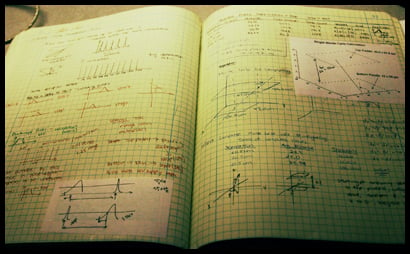
Calculations from Cosmic-Ray Muons Lab
Our first official lab was X-Ray Physics– the 15 part experiment. Unfortunately for my partner and me, we didn’t realize that some parts were optional until we’d gone into 3 extra Friday sessions in a desperate attempt to finish the lab. Extra time was given to our first lab to account for equipment familiarization and just general intimidation.
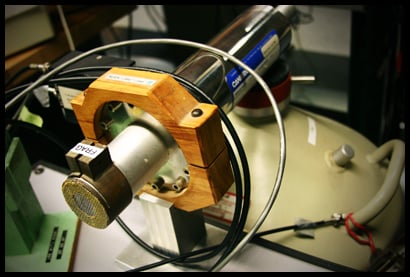
Our germanium solid-state detector. The ionization chamber is kept at a chilly ~80K to reduce noise- underneath it there you see the nitrogen tank.
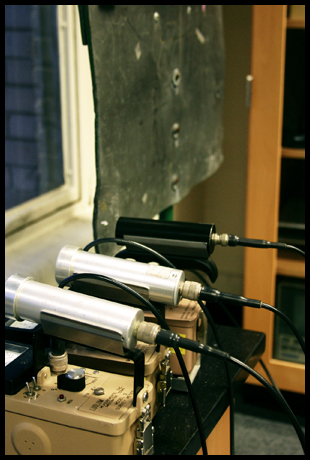
Row of Geiger-Counters :P… sitting on a lead box full of radioactive isotopes. We go into this box a lot for the X-Rays experiment.
This is my graded first paper: Experiments in X-Ray Physics. It was way too long. It could have been better– a lot of work went into this though. The most rewarding thing about this whole course is really the improvement. Mostly through repetition and the sense of urgency, you feel yourself becoming a more fluent experimentalist with every lab you complete. I’ve uploaded three papers into the same folder linked above. Take a look if you are interested in the kind of written product we churn out, but by no means feel obligated :) The other two aren’t graded, I’m not sure where I put their graded counterparts. (Note: I did not upload the Rutherford Scattering lab. Because I hate it.)
Here, take a look around:

Foreground: really ghetto way of shielding the Rutherford set-up from photon noise. Background: The saddest tree on earth.
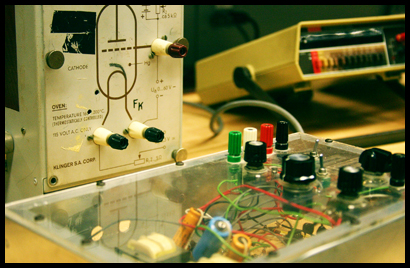
An experiment I did not perform. I have no idea. Maybe Frank-Hertz? Maybe second semester.
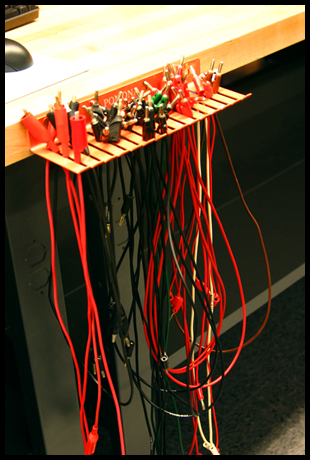
Lots of cables with alligator mouths :)
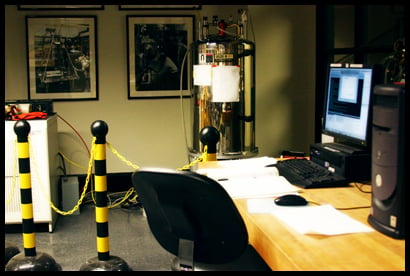
Our quantum computer. I hear the concept is awesome but the lab totally blows. Grapevine.
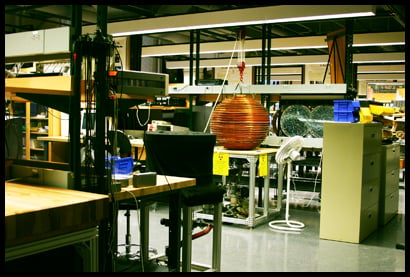
Relativistic Dynamics experiment is the big wire ball with the fan blowing at it. We wanted to do this one but we did not get it, we wanted muons more.
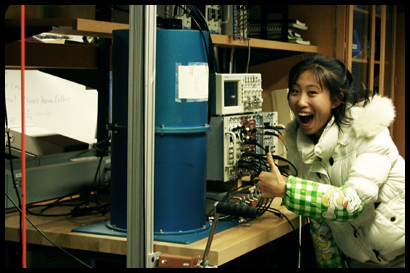
Speaking of muons… muons are great. Here’s me standing next to the plastic scintillator for muon lifetime experiment. Muons are flying through my body, and I’m lovin’ it. Thanks Scott for the picture :D Scott is fun. Scott will save your life multiple times, I guarantee it.

Compton Scattering! It’s okay, I hear.

The magnets for it.

Alpha decay, the final lab we did. The set-up looks so weak but it’s considered one of the hardest experiments.
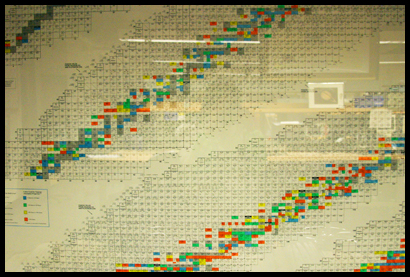
Table of nuclides. We had to memorize this. No, I’m kidding.
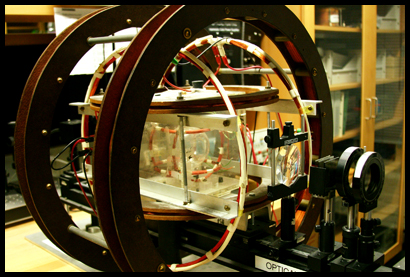
Optical Pumping next semester. I hear this one is temperamental. Will do my best to avoid.
Oral presentations are a pretty big part of Junior Lab. With every paper is an accompanying 15 minute PowerPoint presentation (here, I’m giving the example of my slides from Alpha Decay, which I ended up choosing for my public oral as well) given to the professor and TA of your section. These are videotaped for review with a communications instructor. In total, 5 are taped in these settings and the last is a public oral given to the class and all the instructors and all your friends and are supposedly taped and put on the internet– I haven’t been able to find it thusfar, but I’ll put my public oral up if I do. Mine was well-attended seeing as I invited my hall.
The public orals are held in succession and in these big end-of-term parties with pizza and drinks and victory speeches given by professors like football coaches after a big game. You’re encouraged to come back for another semester: which the eventual 8 majors do, but some don’t. We lose friends, partners. I’m sad to report that my partner will not be joining me in 8.14. Likewise, my new lab partner, Chris, is also newly orphaned.
All in all, a busy semester behind me and an equally busy semester ahead, I’m going into the last week of IAP feeling not quite as bored and relaxed as I would have hoped, knowing once semester starts it’s another marathon to the finish. Spring semester has been historically more manageable for me, I like the days getting longer the breeze getting warmer, the flowers and the leaves on trees and just the whole outlook really agrees with me. On my plate is 8.14, 8.06 (Quantum III, communication intensive, with a paper at the end), a writing class yet to be decided, and perhaps a history class. I’m leaving some time to do work for the non-profit I’m a part of, to be a cheerleader, to publish our lit/art magazine, and start research for my senior thesis. A new terms is nigh; there’s no time to waste. 4 years go by pretty quickly.
-Lulu
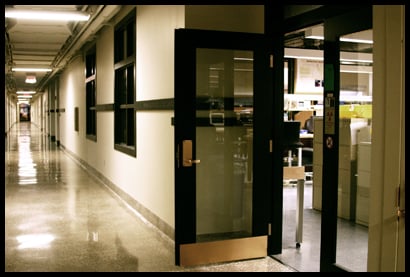
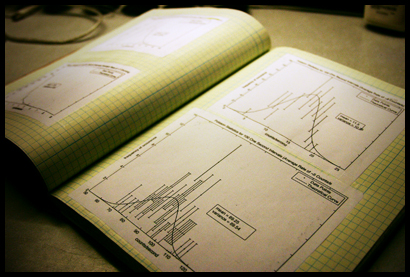
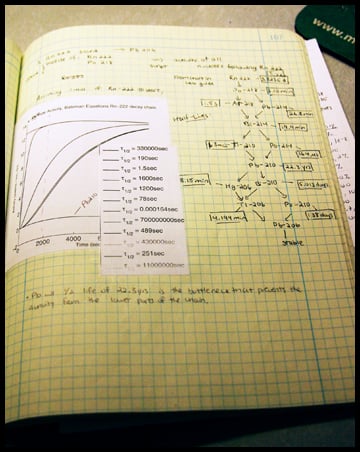
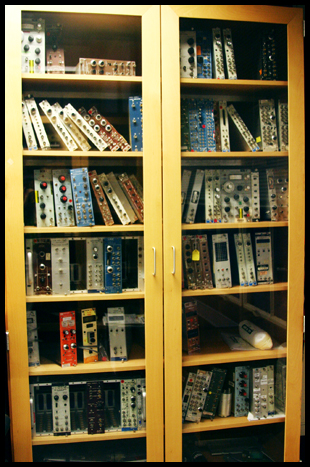
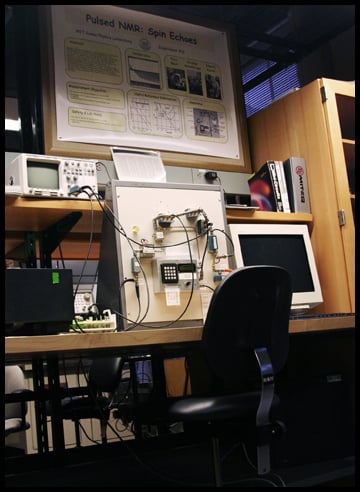
Awesome Blog Lulu!
I I <3 lab notebooks.
Wow, once again great post. This makes me want to be an course 8, I love labwork and experiments. So much material…so many machines…
I’m reading your alpha decay paper ! (and downloading Debussy – Clair de Lune, if you don’t mind.) You made me curious.
Yeah! The Wild Wild MIT..Love this.
Even if I don’t get into MIT for UG, can I come there later for research. I so love this place..just by seeing this picture. Seriously, one can spend the whole life learning something or the other about metaphysics or aerodynamics. Hey Lulu, please please…next time..let your blog be about Wind Tunnel and other aero related research opportunities at MIT..please…
Wow that looks so cool….
I think I’m going to be a math major. But then I see posts like this, and I remember I like experiments too! Oh, decisions decisions. Good thing I have some time .
.
Curiously, what made you choose to switch from wanting to do course 16 to course 8?
I really want to major in course 8 at MIT. I can’t wait till March! I love these posts Lulu, lets me know what I’ll be getting into. Keep them coming!
That’s the same lab notebook I used in my chemistry class! …in high school, of course. Ah, the carbon paper is annoying…but convenient.
Yay cheerleading!
I was thinking of coming by one night a week this spring, after I finish an evening class I’m taking the first month of the semester. I need to get big and strong again.
Lulu, thanks for an amazing blog. Junior Lab looks intense, but invaluable.
Wowwww… I applaud you. That looks like an amazingly huge amount of work.
Wowwww… I applaud you. That looks like an amazingly huge amount of work.
Your notebook is utterly-butterly neat and clean.. and good looking too!!! How did you manage that..??
and awesome blog anyways!!!
WOW!
WOW
no wait
W-o-W!!!!!!!!!!!!!!!!!!!!!
this is the post i’ve been waiting for all my life (well ok two years actually but STILL)!
i*heart* physics ansd junior lab sounds amazing!!!
If by some miracle i get into MIT , I’m walking in and picking course 8 as my major on day one! (wait can that even be done?)
=)
is the ionization chamber the wilson’s cloud chamber thingy? We learnt that this year under nuclear chem
hahahaa…typos in my blog url
thwe kweys arwe STUCK!
Cool!
…But who let them use Comic sans for their headers?!
MACHINESSSS!!!
Yeah, I have absolutely no idea what I was doing this IAP – I just found myself going to classes and attending lectures and stuff. Fun stuff!
hi lulu! thanks for a great blog on physics @ MIT. i am really interested in majoring in physics and blogs like these are a great opportunity to see how it is like at MIT. well first of all, I wanted to ask you if you have been working with Dr. Sara Seager. I recently attended the AAS conference and listen to a very interesting presentation by her on extrasolar planets, where i was able to speak with her and i asked her about physics at MIT. im currently working at my local university on radio pulsar where theyre used for gravitational waves detection. when i saw that your work was on extrasolar planets detection i thought u might be possibly be working w/her. hopefully, i can continue on my research once at MIT or get a UROP opportunity to work with other professors highly involved with LIGO as i’ve seen. Another question that i wanted to ask u was about swimming. u mentioned u were involved in swimming (oh and contratulations on the flip turn!, i also had a hard time learning those) and i wanted to know if this was in the varsity team or another team. ive been involved with my schools swimming team and wanted to know how it was at MIT and also the admission requirement for the varsity team. ive heard that for some varsity sports u dont even have to have previous experience but i dont about swimming and how fast these qualifying times had to be if they exist. well, sorry for writing and asking alot stuff. i really appreciate it. good luck on that thesis.
-sam r.
aww i love the first comment.
also i can’t focus. (but only for the first time today! go me!!)
berglar
Female physics majors who are also cheerleaders…that’s just awesome.
Dear Lulu:
I’m so surprised that we have the same nickname
^_______^
MIT is always an amazing place in my dream that is sure to broaden our horizon.
However, my hometown is located in Jinan(Shandong,China)which seems to be a relatively closed place. Even if there’re almost no chances for me to take SAT,I won’t give up my hope to apply for MIT entrance.It is try that makes up our colorful lives,right? Could you please give me some advice about it? I’m looking forward to your reply.
by a Chinese girl—Lulu
“Curiously, what made you choose to switch from wanting to do course 16 to course 8?”
lauren- That question really does deserve a much longer answer than this, but in short, I took a semester of Unified (the course 16 sequence for sophomore majors) while starting on a physics sequence, and didn’t like what I saw. There were two objections: 1) HOW engineering classes expected you to learn, and 2) WHAT engineering classes expected you to learn. First of all, I much preferred building things up from a few basic principles and really understanding why things work the way they do as opposed to memorizing tricks and “methods” to solve complex problems. To be fair, the real-life problems solved in engineering classes (at least the higher level ones) can rarely be reduced to an elegant, physics statement. In real life, things aren’t perfectly rigid, or frictionless, or point particles. Still, I felt like if you really knew how to deal with problems in their limits (perfectly rigid dah dah dah…), later on in life when you are building something and have to deal with all sorts of variables, with few adjustments, and maybe a little bit of research, you can very easily solve these and all other extended, real life, problems. But more importantly, you’ll also have a great intuition for why it is that your methodology works and what the right answer should be. It’s this intuition that I hope to build in my physics education– MIT has one of the best undergrad physics curricula in the country– and physics is all about building intuition for the world around us. Engineering, to me, at least, appears to be much more focused on teaching its students skills (and that makes sense of course if your goal is to graduate people who can start producing right away out of college); these skills include Matlab, SolidWorks, power tools and machine shops, Perl maybe, or Java, STK, Thermal analysis programs, CAD… you get the picture. So that you really graduate knowing everything you need to know to do a certain job (and really well, too), but it lacks the flexibility of physics since your knowledge is quite specific. But you don’t miss out on anything, really, being a physics major. This past summer I did an engineering internship. Learned how to use Matlab, STK, Latex, and to a small extent, Solidworks, on my own over the course of a few weeks and was just as productive as any intern there majoring in engineering. This leads me to believe that the skills you gain as an engineering major are skills that are easier to pick up LATER ON IN LIFE than the skills you gain as a physics major. Well, that’s just what I think. You should probably also consult someone who switched from physics to engineering
Yikes! ^ that wasn’t a short answer at all.
Mollie- We’d be happy to have you :D
Aditi- An ionization chamber can be found in a whole mess of detection devices. In our lab, we mostly have solid-state detectors, which means that a solid is used to detect ionizing radiation. These detectors are good at signaling the PRESENCE and ENERGY of particles/radiation but give little information about their paths. On the other hand, cloud chambers are most useful for seeing the paths of these particles.
Sam R.- Prof. Seager is a member of the TESS science team I have not personally worked with her since I’ve so far been on the engineering/instruments side of things, but she is mentioned quite a bit, and she made a visit to California this summer while I was there for an exoplanet conference as one of the speakers.
I have not personally worked with her since I’ve so far been on the engineering/instruments side of things, but she is mentioned quite a bit, and she made a visit to California this summer while I was there for an exoplanet conference as one of the speakers.
lulu- my advice is apply to a lot of schools, esp some public schools, if you want to study in the US
physics is amazing, junior lab looks amazing, this blog entry is amazing, mit is amazing, female physics majors are amazing…
Thank you very much for your suggestion.
I’m so happy that I’ve got a smiling feature:).
I’d love to keep contact with lulu in the future.
^______^
Best wishes and goodnight(Sorry,this is according to Beijing Time)
you bought your own??
$40???? Mine cost $14…
Wow, thanks for that response! Really enlightening as to the way different subjects are approached, though I’ll have to find out for myself when I get there!
Awesome post– the pictures make me shiver, literally. But a good kind of shiver…
Ah, for March to come and fat letters (*hopefully!* *In the words of the Beatles, “Please Please Me!”*) to arrive! Your synopsis of the differences between engineering and physics was quite enlightening, spoken with much wisdom. I think I’d have to give both a try before any final decisions…
Thanks again for the great post!